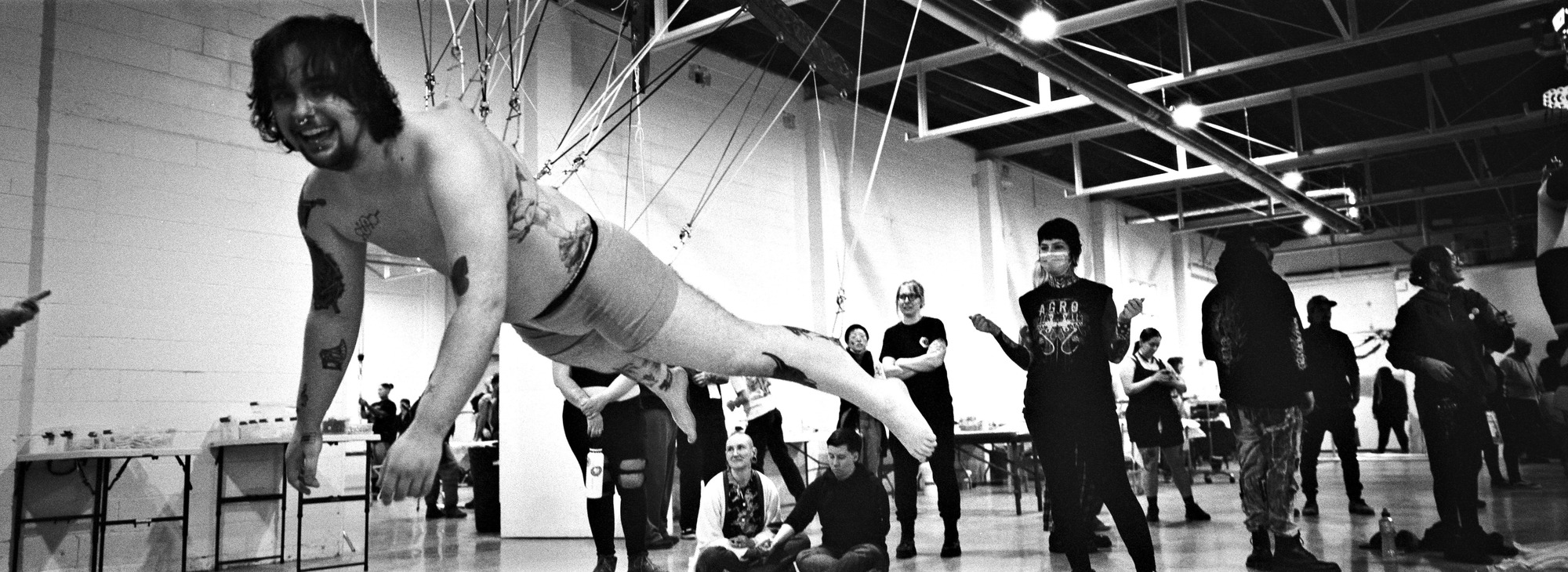
|
-
Love at First Bite [The Publisher’s Ring]
Written by
-
BME Newsfeed for Mar 29, 2005
Written by
- 2005-03-29: United Kingdom: Lip piercings ‘can shrink gums’ [by LostVoodoo]
Please note that links may expire. IAM members, please help out by submitting stories!
-
Spreading the Word and Remembering Sailor Sid [Running The Gauntlet – By Jim Ward]
Written by

IX. Spreading the Word and Remembering Sailor Sid
A huge part of Gauntlet’s success was probably the result of the tireless effort I put into promoting, not just the business, but body piercing itself. Over the years I traveled regularly giving presentations to everything from S/M organizations to university human sexuality classes.
A lot of people take it for granted that they can go into almost any tattoo shop and get a body piercing. Believe it or not, that has not always been the case. To some of us it seemed self evident that tattooing and piercing go together like salt and pepper. But there was a time when many tattooists were outraged at such a suggestion. Having a personal interest in both and knowing many others who shared it, it seemed logical to me that the tattoo community was just waiting to embrace my efforts. It didn’t take long for me to find out otherwise.
Early in 1977 the International Tattoo Artist’s Association (ITAA) was having a convention in Reno. In an effort to reach out and spread the word amongst the tattooed, Doug suggested that I get a vendor booth there. I submitted the necessary forms and was accepted. This would be one of our first appearances in public.

Tattoo legend Cliff Raven (right) with an adoring admirer.

Tattoo Samy from Frankfort and his wife Ella.

Some of Samy’s tattoos and piercings.

A young Ed Hardy.
I made up an assortment of jewelry and gathered a selection of piercing equipment and set off with Eric and Doug for Reno. We were greeted by a number of familiar faces. Cliff Raven and his lover were in attendance as was our friend Tattoo Samy from Frankfort and his wife Ella. We also met Ed Hardy who was doing very extensive tattoo projects on a couple of members of the T&P group. Fakir was present and had been asked to provide entertainment at the banquet.

Jim, one of the people I pierced at the convention.

Karen after her nipple piercings.

Steve Richards, a young tattooist, volunteered to have his nipples pierced at a public demonstration.
Outwardly everyone was courteous and curious. During the course of the convention a number of people made arrangements to come to our room for private piercing appointments. Among them was the girlfriend of Dale Grande who had done tattooing with Cliff Raven when he had his shop in Chicago. I was even asked to do a nipple piercing demonstration on the floor of the vendor area. A good looking young tattooist named Steve Richards volunteered to be my subject.
The demonstration went well, and many people stopped by the Gauntlet table to ask questions. On the surface it appeared we were well received. But unknown to us there was trouble brewing. A number of the big name tattooists, among them Ed Hardy, were not pleased.
“Since Ed Hardy had brought the subject of piercings up at the I.T.A.A. Reno Convention in 1977 (he felt, as did the overwhelming majority of Artists there that piercing did not belong at a Tattoo convention and should not be linked to tattooing. I.T.A.A. Members voted there and then not to have piercing at future conventions) it was decided on (by the suggestion of Bob Shaw) not to allow facial tattoos or piercings at the National Tattoo Conventions. This was to be a Convention to promote Tattooing and only Tattooing.”
(source)Fortunately not all tattoo organizations were as hostile as ITAA and NTA, but the Reno convention was the first and last tattoo event that I recall Gauntlet ever vending at. For years to come the applications for at least some conventions carried a statement reading in effect that, “we will not rent vendor space for piercing or anything else that might give tattooing a bad name.” This is pretty much a direct quote. What I would love to have pointed out, but never did, was that bad tattooists were far more likely than we to give tattooing a bad name.
This attitude toward piercing persisted with some tattooists for a decade or so. Then in the late 1980s when the popularity of body piercing exploded, some savvy tattoo artists realized there was money to be made doing piercing. Almost overnight there was a huge shift in attitude, and tattooists around the world began setting up shop as piercers whether they were qualified or not.
The following April another tattoo convention was to take place in Texas. Although vending was no longer an option, Doug and I planned on going to hand out business cards and meet people and promote our favorite form of body adornment.
Plans were progressing well until shortly before we were to leaving for Texas. Doug approached me and said that after giving it some thought he felt it wasn’t worthwhile and that instead we should take a vacation to Key West and then go up to Fort Lauderdale and spend a few days with an outrageous piercing and tattooing enthusiast, Sailor Sid. I took him at his word and didn’t think anything further about the change of plans. Later it came out that the real reason for the diversion was that Doug had learned his youngest son Robert would be attending the Texas convention and that he wanted to avoid running into him.
We flew into Miami, rented a car and took to the road 160 miles south to Key West. I particularly remember the series of bridges that link the chain of small gulf islands with the mainland. We passed through Key Largo, an easily forgettable place whose name at least we’ll always remember thanks to Bogart and Bacall.
It’s funny how memory plays tricks on us. When I first started writing this article it seemed like Doug and I had made only one trip to Key West. But when I began looking through photos and examining the dates stamped on slide borders, I realized that we had actually made two trips to that sunny destination.


Doug and I enjoying a boat excursion on the Gulf of Mexico.
In truth much of the memory of this trip is pretty sketchy. I’ve no recollection whatsoever of the hotel where we stayed. I do recall doing many of the usual tourist things. We explored all the usual tourist traps on main street. I still have a hand made silver belt buckle we bought on this trip. We visited the home of Ernest Hemingway and lunched at some roadside shack on the beach where we ate stone crab — the first I’d ever tasted — simply prepared, fresh, and delicious. Doug also hired a boat for us to have an afternoon and sunset Gulf excursion. I still have the slides we took.
Doug had a personal connection to this Southeastern tip of the United States. He told me that the island might well have belonged to Cuba, but in 1821 an ancestor of his had purchased it thus making it part of the US.
“In 1815, Spain deeded the island to a loyal subject and St. Augustine native, Juan Pablo Salas. In 1819, all of Florida was ceded to the United States. Salas had made no improvements to the island of Key West and sold it to John Simonton, an American businessman, for $2,000. Simonton understood the potential of Cayo Hueso’s natural deep-water harbor and divided the island into four parts, selling three of them to fellow businessmen Whitehead, Fleming and Greene, and keeping one for himself. By this time, the island had been renamed Key West, probably as a result of an English language distortion of the original Spanish name.”
(source)
One of the sites we took in was an old fort that had been turned into a museum. In one of its many rooms we came across a portrait of John Simonton.
After our Key West venture came to an end we loaded up the rental car and headed north to Fort Lauderdale to spend a few days with the self proclaimed “freak nut” who went by the name Sailor Sid Diller.
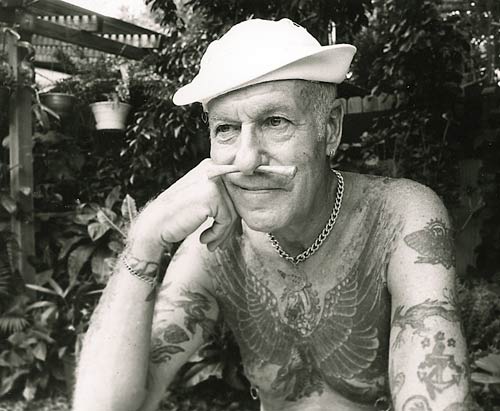
Sailor Sid in a photo I took of him in 1980.
To say that Sid was a character is putting it mildly. Generally speaking I think he was a kindly and good hearted person. He could be a source of endless humor although he had a tendency to repeat the same joke or bit of business often to the point of painful irritation. I found him to be genial for the most part, but after spending some extended periods of time with him, discovered he could be quick-tempered, irritable, and occasionally petty especially where money was concerned. From my perspective he was a difficult man to get to know and warm up to. The freakish side of his persona was always on display. It was a façade that was firmly in place, and he rarely allowed anyone to see the real person behind the mask.
Sid was in his late sixties when I first met him. He had been fascinated with tattoos from the time he was preadolescent. Sid had been a member of the Coast Guard which, during World War II, was a part of the Navy. It was in those war years, the early 1940s, that he got his first piercings — ear and frenum — and tattoos. If memory serves me correctly he became an electrician after leaving the service and settled down in Ft. Lauderdale, Florida where he retired.
Sid’s passions were tattooing, piercing, and very heavy S/M. He had managed to connect with a large number of other enthusiasts throughout the world and was a voracious correspondent, writing at length — on a typewriter, no less — about his experiences. Photos of his exploits and those of others were often included. No doubt BME enthusiasts would hardly find them shocking, but for their time these included some of the most extreme S/M I had ever seen documented, including extensive play piercing scenes and some involving opening the scrotum and exposing the testicles.
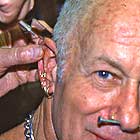
Doug piercing Sid’s ear.
Doug’s and my visit did not include any of these particular activities. Sid took us to a gay bar or two — pretty tame ones by LA standards. He also arranged a big piercing party at his home for various gay friends and fellow motorcycle club members so they could drop in and get pierced.

The piercing party in full swing.

Sid clowning.
At this point in history the Jim Ward name didn’t mean very much in piercing circles. Sid didn’t really know me, and his assumption seemed to be that Doug would be doing a lot of the piercing. Aside from acquiescing to Sid’s desire for a piercing or two from the hands of the “Master,” Doug very graciously sang my praises as his protégé and made it clear that I would be doing whatever piercing services were required.
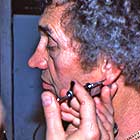
Doug got his ear pierced as part of the festivities.

Doug giving Sid an apadravya.

The answer to the perennial question.I pierced at least eight people that night, some having multiple piercings. Doug got into the spirit of the evening by letting me pierce his ear. Being as closeted as he was, it came as no surprise that he removed the jewelry by the time we returned to LA. Sid got his wish when Doug added another piercing to his ear and gave him an apadravya. The atmosphere was congenial and supportive, and everyone seemed to leave on an endorphin high.


During our visit Doug and I also met a kinky straight friend of Sid’s named John. My impression was that John enjoyed cross-dressing or at least expressing the feminine side of his nature. Both legs were tattooed with lace stockings made up of hundreds of tiny spiders. His toenails were painted. In many of his piercings he wore jewelry of a decidedly feminine character. John was probably the first man I ever encountered who had split the head of his penis. It wasn’t difficult to understand why he and Sid were friends.

Sid’s kinky straight friend John,
perhaps the first man I ever met with a split penis head.
Our stay in Ft. Lauderdale was pleasant, and we returned to LA having made many new piercing friends.
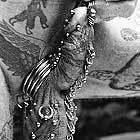
A closeup of Sid’s genital piercings taken during my 1980 visit.
I visited Sid again in 1980 to interview and photograph him for PFIQ. That interview appeared in issue #10. I’ve never considered my skills as a photographer to be particularly outstanding, but I have to say the pictures I took of Sid are among the best I’ve ever done. He was relaxed and open and never camera shy. The photos I took that day always remind me of one of the most unforgettable characters it’s been my privilege to know.
Sid kept two collections of personal papers that I know of: the correspondence and photographs he’d accumulated over the years relating to tattooing and piercing. When he died May 24, 1990 — age 80 if my calculations are correct — he had already made provisions for his collections to go to people he trusted. I believe he left the tattoo papers to his good friend Jack Yount. I’ve no idea what happened to these after Jack’s death. The piercing collection Sid left to me. A few months after his death a couple of large, heavy boxes arrived for me at Gauntlet’s corporate office. In them were a number of three-ring binders filled with photos in plastic protectors, not to mention a large stack of correspondence. Not only were there many letters from his various and sundry friends, but oddly there were photocopies on thermal paper of many letters Sid had written to them.
For some time I pondered how best to preserve this unique collection and also make it accessible to interested individuals. I considered using some of the material in PFIQ, but since there were no photo releases, and I didn’t know most of the individuals pictured or how to contact them, I abandoned that idea.
As time went by my health became somewhat uncertain, and I was forced to face the fact that I might not have that many years to live. I was concerned about the future of the unique collection Sid had left in my care and felt the best thing I could do was to find a better home for it. Eventually I made the decision to donate it to the Leather Archives and Museum in Chicago. It’s clear from their web site that the collection is still there. I’m assuming anyone interested in exploring this resource can make arrangements to view and study it.
Sid was one of a kind: a man who marched to a different drum and made no apologies for it. Despite any differences we might have had, I consider myself fortunate to have known him.
Jim Ward
http://www.gauntletenterprises.com/IAM members click here to discuss this article.
Jim Ward is is one of the cofounders of body piercing as a public phenomena in his role both as owner of the original piercing studio Gauntlet and the original body modification magazine PFIQ, both long before BME staff had even entered highschool. He currently works as a designer in Calfornia where he lives with his partner. Copyright © 2005 BMEzine.com LLC. Requests to publish full, edited, or shortened versions must be confirmed in writing. For bibliographical purposes this article was first published March 29th, 2005 by BMEzine.com LLC in La Paz, BCS, Mexico.

-
Hola Gringo!
Written by
BME Visits BodyFest 2005 in Mexico City “When you bring an act into this town, you want to bring it heavy. Don’t waste any time with cheap shucks and misdemeanors. Go straight for the jugular. Get right into felonies.”
– Hunter S. Thompson (RIP), Fear and Loathing in Las Vegas
It was 8:15 a.m. when my flight reached cruising altitude, and then there was certainly no turning back. The trip that had been the bane of my existence for a week’s time — the weekend that the thoughts of which had caused my nerves more damage than leaving my home in Toronto to actually live across the continent — it was underway.
All things considered though, I was taking the event in a more heroic fashion than I had imagined I would be.
Traveling is a new beast to me. Until the third of March this year, my minor voyages had been limited to the American northeast — never west of Detroit, and never south of Camden, New Jersey. And certainly never on a plane. By the time I was en route to Mexico City on the morning of March 12th, my flight experience had propelled me past the stage of gripping the armrests to the point of muscle tears, and turbulence was no longer a source of intestinal unrest. It was the trip itself, a weekend as a tourist in a metropolis known for devouring tourists, leaving them penniless and beaten by the city limits, that gripped my psyche, throttled my sanity and sent my neuroses to the front lines.
I may have been blowing things out of proportion.
The city is absolutely immense, and there’s no mistaking that. The airport was quick to calm my nerves though; it was practically a merry-go-round compared to, say, the blazing re-entry wreckage that is LAX — a newfound mortal enemy of mine. Within minutes I was in a taxi, where it quickly became evident that the statistic of one being safer in the air than on the ground on the way to the airport was founded in Mexico City. After forty-five minutes of the most diabolically terrifying driving I’d ever been involved with, my heart riding shotgun at the roof of my mouth and my bowels lagging behind, somewhere around the rear axle of the cab, I arrived at my destination of the Rockotitlan club, site of the purpose of my trip: Modificaciones Corporales Tatuajes’ BodyFest, featuring Lukas Zpira.

I was struck immediately by the amount of heavy work — very large-gauge piercings, visible and facial tattoos, implants, etc. — and that it was by and large quite well done, and worn largely by surprisingly young people (eighteen to twenty-five, roughly). While the volume of this manner of work is certainly present in any convention-type setting, seldom have I seen it in this predominantly younger age bracket. Following closely behind as far as immediate impressions went was the fact that I was quite obviously the only person who spoke English as a first language in several city blocks, and certainly the only one in the building. Thankfully, both Rafael and Beto were more than willing to help this desperate gringo translate his way through the weekend with the multitude of tongues at their relative disposals.
The day began with a seminar on cutting by Lukas in a tent set up on the terrace outside the club. While no actual work was done on the spot (though a piece was drawn onto a client to be cut later on in the day), he spoke to and fielded questions from the audience for a little over an hour, and it was really quite interesting to watch the information transcend several language barriers. The seminar was conducted in English and was then translated into Spanish by a volunteer from the audience, but on the occasions that Lukas would get tripped up on the proper English terminology (from his native French tongue) his wife Satomi — also bilingual — would then provide him with a French-to-English translation. The crowd, though, was very giving and professional — exercising patience not often seen in Canadian or American events. It would seem that while people in those markets generally like to think they’ve already got the facts and the know-how, the BodyFest contingent was extremely receptive and devoured the information — they needed it. The same was true for the following day’s seminar, which was split up into two sections, one for branding and the other for implant procedures; the same format as the previous day was in effect, with most of the time being spent on Lukas fielding the eager audience’s questions.

Lukas Conducting the Cutting Seminar
Designing a CuttingIt was suggested to me that perhaps it was dangerous for Lukas to be divulging this information to the people there, that it might give them the impetus to jump into performing procedures that they weren’t ready to do yet, or at least not do cleanly and safely. However, it was relayed to me that, before I arrived in the city, some people had ventured to the downtown core and witnessed implant procedures being done right on the sidewalk.
One more time, with feeling: People were doing implants on the sidewalk.
And not well, by the sounds of it. Mexico City is not known for its particular cleanliness to begin with and, as Lukas would explain, the care you must take when performing implants is much higher than when cutting or even branding. There is no city block in the world that would be the appropriate location for that procedure, especially when the facilitators are haphazardly dropping instruments on the ground and, after what essentially equates to a spit-shine, continuing to use them. But the popularity is there. People are going to be doing these things whether they’re safe or not. The fact that Lukas was providing an outlet for these people to at least learn proper techniques is commendable, though unfortunately, it didn’t seem like the street-team contingent was in attendance.

By nightfall I was delirious with hunger, but not wanting to miss any of the event combined with a mostly-irrational fear of the local food kept me from taking a break for dinner. My pangs faded with time though, and I was right to keep a close eye on the proceedings — a suspension performance not listed on the program kicked off the evening portion of the event. The duo — a larger fellow in a spiked and studded leather bondage mask and his scrawny partner in a gasmask — hit the stage, the bigger member hanging suicide-style while his diminutive friend began with hooks in his upper back as well as his knees, swinging around above the ground in a crouched position. While not groundbreaking techniques, the show delighted the crowd. The atmosphere was much more that of a festival than a traditional convention — industrial dance music blaring through the PA at all times, and large projection video screens set up to broadcast in real-time what was occurring on stage, as well as to show Lukas performing procedures in a smaller tent-studio — enclosed in clear plastic — set up on the upper level of the club. Once the smoke (machine) cleared and the performance came to a close, I headed upstairs to check out a cutting piece in progress.


Lukas works extremely fast.
The piece being worked on was in fact the one he had designed following his cutting seminar earlier in the day — an odd jagged vision with sinister witch-like faces worked into it — that, in spite of covering much of the client’s thigh, was nearly complete within roughly ten minutes of being started. Luckily I caught the tail end of the process and was able to see for myself the speed with which he conducts himself. Lukas has a wide range of experience under his belt — he is more often than not on the road working in countries all over the world — that surely contributes to the speed at which he is able to work, but it’s his confidence in the work itself and his own abilities that seems to be the deciding factor. This was even more evident the following day when he, with the aid of Satomi, completed a large implant in someone’s forearm in literally less than four minutes — a procedure that easily could have taken other artists over an hour. His uncanny precision, custom-made PTFE instruments, and the symbiotic relationship he and Satomi display when performing this kind of work truly set him apart from other practitioners in the field.


With a criminally cheap, oversized beer in hand, I settled in for the next performance, not prepared for the spectacle that was to follow. Another troupe — again, not listed on the program — marched onto the stage, adorned in what appeared to be some variation of Nordic warrior garb, some brandishing weapons, others playing drums, horns and flutes — there was even a guy with bagpipes.
Seriously. Bagpipes.

As the percussion-heavy yet highly listenable music began, two men were suspended vertically from their chests in the center of the stage. As well, a semi-circle had formed around another member of the group who had stationed himself on the floor of the club rather than on the stage. Wearing various pieces of armor and a grotesque hog of hell mask, he unleashed guttural death-metal throes that would not have been out of place in front of a crowd of 30,000 screaming Norwegians, all the while stomping around the perimeter of his area and clanging his sword and shield together.
(Let me note that by this point in the evening, I was really cursing myself for not knowing any Spanish, or at least bringing a Babel fish along with me. The Mexicans (some from Mexico City, others from Guadalajara), as well as the Guatemalans present, were all terribly gracious and accommodating, often apologizing for their poor English when speaking to me, when really, I’m the nitwit who moved to their country without speaking a word of the language!)
Just when I thought the theatrics had reached a climax, a few fellow warriors joined the pig-man on the ground, and then the unthinkable: A firefight broke out. One of the newcomers began blowing flames at the orc-ish character who blocked them with his shield, when another of the new arrivals began tossing a flaming sphere up into the air and catching it with relative ease.
For those keeping score at home: Drummers and percussionists, flutists, horn-players, bagpipes, chest suspensions, death metal vocals, swords, fire, and pig-men. Merely calling this a spectacle would be on par with calling syphilis an inconvenience.



After a break in the action, a mélange of people outfitted in bondage and S&M gear took to the stage in procession — to enormous applause — and a simulated sex show ensued. While the men occasionally took the upper hand, the show saw the women generally dominate their male counterparts with a variety of whips, chains, and riding crops. Here, the audience impressed me; maybe I’m just cynical, but I still expect most people I meet to have some sort of homophobic tendencies about them — especially in developing nations where religion and history are more pervasive to modern day society. So imagine my shock when one of the women whipped out a massive dildo, began toying with the ass of her scantily clad slave, and the male-heavy crowd — after a brief “Is that what I think it is?” moment — cheered even louder than they already were! Nary a disgusted grunt could be heard in the place; these people paid good money to be there, and damned if they weren’t going to see some simulated anal violation live on stage. Very pleasantly surprised.
The cavalcade of smut — and I use the term lovingly — exited stage left, which meant it was nearly time for the evening’s main event, if you will, featuring Lukas and Satomi. With a crowd gathered close to the foot of the stage, the industrial music segued into gentler, poppier techno-beats, smoke filled the venue, and a comely young lady wearing only bikini bottoms emerged through the haze. Planting herself on her knees, hands folded in her lap and head down, another figure made its way into the light: It was that of Satomi, dressed in head-to-toe black, and rope in hand. Thunderous applause roared from the audience as they took her in in all of her dominatrix glory, now towering over the petite, seemingly demure girl at her feet — on which she wore platforms giving her at least another six inches of height. After sizing up her victim briefly, with a swift gracefulness, she began to bind the girl’s hands behind her back.


The act continued as Satomi brought the girl to her feet and, with skillful precision that would have left a Boy Scout shaken and traumatized, tied a series of complex knots around her arms, torso, and through her legs; escape, she showed, was impossible. She then whisked the girl to the side of the stage, and out came Lukas with a harness around his chest and hooks already in his back, ready to be suspended. Once he was in the air, the bound girl was reintroduced into the equation — Satomi was going to tie her to him. Flawlessly fastening more devious knots, this time around attaching the girl’s legs to the web of rope in her back, she then ran the rope through a ring in the middle of Lukas’ harness and lifted the girl off the ground through it and tied it off, leaving Lukas to support her weight as she hung off of him. With a malevolent smile, Satomi then dug a knee into the young girl’s back and proceeded to climb atop her horizontally-suspended body, putting immense pressure both on her and Lukas, and judging by the approving cheers from the audience, they certainly appreciated the difficulty of the act. The crowd left quite satisfied it seemed, some of them certainly having had their eyes opened to something entirely foreign, but exciting nonetheless.


The second day’s festivities closed out with another suspension performance, yet one in a much different vein; with the stage encircled in soft red candles and gentle sounds of nature pulsing from the speakers, Beto sat patiently in a trance-like state while Lukas pierced his back and knees, and was slowly lifted off the ground. With unremitting concentration and purpose, he hung nearly dead still for several minutes before beginning a soft swaying. Certainly a change of pace from the high-action theatrics of the previous day’s performances, but it served its purpose as a smooth comedown and finale to the weekend. In the midst of the serenity though, the rope handler slipped and Beto came crashing down from at least ten feet above, the handler catching the rope at literally the last second with Beto only inches from the ground. He opened his eyes for the first time since being onstage, shot a humored glance to the man who had dropped him, and was raised once again.
In no way do I mean to invalidate any of the other performances, but this one moment got more applause than any amount of seven foot tall mistresses or dildo-on-man-ass action could have hoped for.


The segment came to a close with Beto hanging vertically and his lovely wife coming onstage to latch onto him as they kissed in a mid-air embrace. An art fusion performance followed, but I was quite literally running on fumes by this point and headed back to my temporary place of residence with Marciano of Kaustika, a local piercing and tattoo shop, an incredibly gracious if somewhat intoxicated young man.
Sadly, I’ve omitted the details of a number of other portions of the event, but these were seminars and speeches conducted solely in Spanish without any translation. Unfortunate, too, as many of them sounded quite interesting, covering such broad topics as the History and Methodology of Suspension (by members of Kukulcan, featuring Beto), Ethics in Professional Body Piercing (by APP member Danny Yerna of Wakantanka), Tattoos as a Means of Identification (by Dr. Julieta Gutiérrez López), and the Discrimination of Tattooed People in Guatemala (by staff from the Guatemalan piercing studio Shogun). God knows I’d better be more competent in the language by September’s convention in Guadalajara.
These people definitely got it. In spite of the relative unease I felt from much of the city, those present at BodyFest were some of the most genuine, friendly people I’ve met in the community, regardless of language barriers. I imagine it must have been a similar atmosphere to last year’s Buenos Aires convention, in the sense that holding large-scale events is a relatively new thing to the area and, as a result, the excitement level and the potential for novitiates to gain insight into some of the more advanced procedures and processes are greatly increased (though sadly, according to some of the organizers, the turnout was not nearly as high as anticipated). Also interesting to note is that Internet access in Mexico (Mexico City in particular) is largely very limited — most of the people I spoke to said that they had spent almost no time online whatsoever. I think a case could be made that in America and Canada, the Internet plays a large role in the proliferation of heavy modifications; the fact that in Mexico these ideas seem to truly spread through osmosis rather than through sites like BME — which, again, very few of the people had even heard of — really spoke to me of a very organic desire to get this kind of work done. There’s going to be some really fantastic stuff coming from the Central and South American contingent of practitioners very soon I think (really though, there already is).

And as it turned out, Mexico City was not the den of crime and iniquity that I had been expecting. It’s certainly a place to exercise more caution in some respects than one normally would, but as with anything, a little savvy and some common sense can go a long way. That said, I opted for a subway ride to the airport the next morning rather than taking another taxi. Holding onto my backpack like grim death on public transit sounded far more appealing to me at 6:00 a.m. than ruining the only pair of pants I had while weeping gently in the fetal position in the back of a little green Volkswagen Beetle, whipping through the streets — supersonic — at dawn.
Savvy indeed.
-
Taking it to the Next Level [Guest Column – Stepping Back]
Written by

Taking it to the Next Level “What makes the desert beautiful is that somewhere it hides a well.”–Antoine de Saint-Exupéry, Le Petit PrinceNot only accepting the fact that she’s severely scarred for the rest of her life, Montreal-based professional linguist, performer, and model Ella (IAM:ella) is celebrating it. And by celebrating it, I mean showing it off. And who can complain about a hot girl who shows off her body?
Up until several years ago though, Ella didn’t show off: She did everything to avoid people seeing the scars left by a pot of boiling water falling on top of her at age four. She wore long sleeved shirts the majority of the time until age eighteen, hoping that the questions and ridicule would stop if people couldn’t see that she was any different than them.
It worked the majority of time, and that made her happy until, during her teenage rebellion stage, she decided she was going to show the world what she really looked like, and the long sleeves disappeared.
Ella 
Amina
Expecting an “OH MY GOD” reaction from everyone who came into contact with her, she was disappointed to find that very few people seemed to care. Her attempt at a “‘fuck you’ rebellion thing” seemed to go totally unnoticed.
There are events in our lives that can change our perception of ourselves, our lives, and the world. Ella’s paradigm shift was caused by someone — her then boyfriend — who not only accepted her physical differences, but found beauty in them. The point of view seemed contagious, and Ella’s attitude towards her scars changed. She too began to see them as beautiful; she started to see them as a good thing. Shortly after that, she began modelling.
Her ex-boyfriend was good friends with Jerome Abramovitch of Chapter9Photography, and they did several photo shoots together. Modelling proved to help her become even more comfortable with the way she looked, and soon she moved onto doing burlesque shows at a fetish club run by a friend of hers. She later progressed into television, where she was featured in seven out of thirteen episodes of Kink III, on the Showcase channel. Talk about celebrating your differences.
Amina Munster (IAM:Amina Munster), who I interviewed in February 2005, is planning on coming out with her secret to her SuicideGirls public within the next couple of months. As a child she nearly drowned, resulting in the loss of the fingertips on her right hand, a quarter of her right leg, and half of her right lung. Amina has done a fantastic job of hiding the fact that she is missing parts of her body in real life and online where she’s an active and popular SuicideGirl.
She’s soon ready to join Ella and celebrate the fact that her body is different than anyone else’s. In preparation for an A&E show called “Inked,” who decided to feature Amina on an episode, she had her prosthetic leg airbrushed to look tattooed. In the near future, Amina will show her online fans that she’s not who they thought she was by doing photo shoots that don’t hide her missing leg. She’s hoping for the best, of course, and expects even more positive feedback, much like the comments she got from the people of BME after the article featuring her was published.
The main difference between these two girls is that Ella considers what happened to her as a child as “body modification” whereas Amina does not. Another outcome of Ella’s paradigm shift was that she decided to highlight her scars with scarification: a testament to the fact that she loves how her body has been changed.
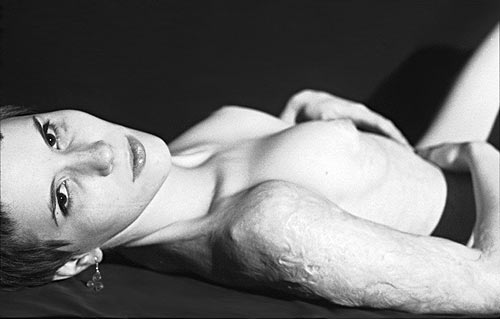
Ella
BME:Although you’ve already written a full experience, would you like to tell the story of what happened to you one more time? ELLA:Sure. The March after I turned four years old, I was in the kitchen while my parents and grandmother were preparing supper. I wanted to help, and they foolishly allowed me to stir a pot on the stove. Through some sequence of events I’m a bit fuzzy on (I think I accidentally dipped my elbow in the pot and overbalanced when I jumped in reaction) I fell down, pulling the pot over on top of me. I ended up with third degree burns on one third of my skin surface and a couple of tiny patches of fourth degree. I spent about a month in the burn ward at the Hamilton General [in Ontario, Canada] during my initial healing, and then another several months at home wearing a pressure garment and undergoing physiotherapy. BME:Do you ever see the nurses or doctors who helped you with the rehabilitation process? If you were to see them now, what would you say to them? ELLA:I haven’t seen any of the medical staff who treated me in years, mostly because I live far away from where I was in the hospital. I’m not sure what I’d say to them; thank them of course, and perhaps ask them some questions about what my treatment actually entailed and why, as I was a bit too young to ask those questions at the time.


Ella several days after the accident, and the day she got out of the hospital.
BME:What would you ask now, if you had the chance? ELLA:I’d probably ask them if my treatment was typical, and if there was anything that they would have done that they were unable to due to my size and age. Off the top of my head, I’d be interested to know how much was my life actually in danger, what drugs was I given, why did some of the skin grafts work and not others…stuff like that. BME:How did your parents deal with what happened to you? ELLA:It was difficult for them — they blamed themselves, and they were far more keenly aware of how much danger I was in than I was. They did their best, and tried to make sure they stayed positive for my sake. BME:Pretend that there’s a new magical medical breakthrough where they can instantly take away all your scars by zapping you with their new invention. Would you do it? ELLA:I doubt it. There are certain small areas I’d like to get repaired, that affect my mobility and the comfort level of clothes, but other than that I don’t think so. I wouldn’t be me. BME:If you did do it, how do you think you’d feel walking out of the hospital? ELLA:I’d feel like I wasn’t myself. At one time, something like that would have made me very happy, but not now. 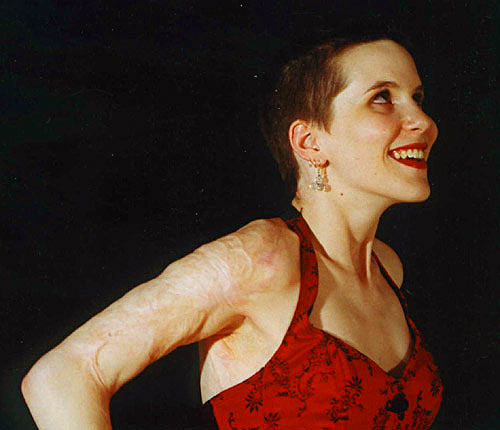
Ella is now very happy with her transformed body.
BME:Do you feel that being scarred makes you a stronger person? What parts of yourself do you feel would be missing if you didn’t have your scars anymore? ELLA:Yes, I think that living with the scars has probably made me something of a stronger person. Our culture is very beauty-obsessed, and doesn’t hold imperfections in very high esteem, and I indirectly get messages all the time that my scars are ‘bad’ in some way. They certainly mark me as having survived a very difficult, life-threatening experience, which is something to be proud of. My ex used to say that I was automatically the ‘biggest badass in the room’, and that has a bit of truth to it. As to what would be missing, I’m not really sure, but I’ve been scarred for the vast majority of my life — I definitely wouldn’t recognize myself at first if the scars disappeared one day. Just the idea feels very strange. BME:Are your scars really erogenous zones? That must be nice. ELLA:Ha ha, yes, they definitely can be. They are very sensitive, and process stimulation very differently from my regular skin. It’s still a bit of a novelty to have someone want to touch my scars in a sexual context, so that has something to do with it. On the flip side, any trauma (cut, piercing, brand) that intersects with a scar is far more painful for me, and many styles of suspension would be extremely difficult to attempt. BME:Are you planning on doing suspensions? ELLA:Definitely, though I’ll probably ease into it with a couple of pullings first. I was hoping to at least do a pulling last summer, but my immune system seemed a bit weak at the time so I decided to hold off until I was in better health. BME:Do you have a lot of people telling you that your scars aren’t body modification? ELLA:I have had some people tell me that, yes. When I first submitted an experience to BME, my first draft was rejected because I only talked about my accident and I was told that it ‘didn’t count.’ BME:How’d you feel about that? ELLA:I was pissed off. I felt that the very people who I was counting on to understand my point of view had completely missed the point. If I hadn’t had other reasons for wanting a membership I probably would have given up on BME in disgust. Fortunately people seem to have come around somewhat in the intervening years. 
Are her burns alone considered “body modification”?
BME:What were the reasons behind your additional cuts and scars? ELLA:I started to see my scars as artistic, and as a kind of body modification, and I think that the scarifications around my old scars are a good way of visually communicating that feeling to others. BME:Was it a hard decision to make? ELLA:No, once I decided what I wanted it was very easy. I was a little afraid of the procedure, but I had no doubts about whether or not it was something I wanted. BME:Were you mostly just afraid of the pain involved? ELLA:I guess so. I didn’t have any real idea of what to expect, or how much it would hurt. The way that the procedure was described to me it sounded a lot more traumatic than it actually was. It was the first modification I’d had other than a couple of piercings, so I didn’t have much basis for comparison. BME:Your first modification to your scars was done by a friend of yours who used a Dremel tool to highlight some patterns within your scars. How was that experience? What did the Dremel feel like? ELLA:It was very easy, it felt like someone was drawing on my arm with a ballpoint pen. The actual scarification process was virtually painless, and it went quickly. My only regret is that it didn’t scar up very well, so it’s very difficult to see. BME:I’ve heard that Dremel scarifications can be a messy (bloody) procedure. Was yours? ELLA:Not particularly — I was expecting it to be but it wasn’t. The blood particles are very small, so it’s pretty messy in terms of being biohazardous, but in my case it was not messy at all in terms of visible residue. BME:Eventually, the Dremel scar faded… what made you decide to try other methods to enhance your scars? ELLA:I still wanted the scarification but nobody could see it. I didn’t think that more Dremelling would result in a much darker scar, so I thought I’d give a branding a shot and see if it resulted in a more clearly visible image. 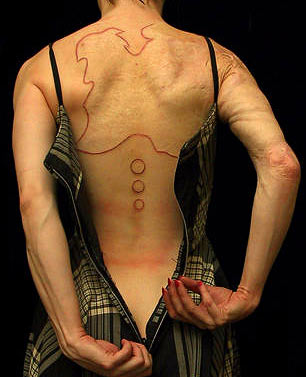
Cutting by Lukas Zpira.
BME:Are you happy with the results? ELLA:It’s a beautiful scar, but even the branding faded a lot — he didn’t really do it deep enough. A couple of years later I had a cutting done on my back which is much more visible. I might stick with cutting in the future. BME:Are the circles on your lower back just a design feature, or do those highlight some of your scars as well? ELLA:The circles are just decorative, as far as I know. Lukas felt that they made the image more balanced. BME:Do you ever go through stages of disliking your scars, or are you really just in love with them? ELLA:I like my scars a lot, these days: I’m generally ‘in love’ with them. I get annoyed by them occasionally when they restrict my movements or behavior in some way (I have to be extremely conscientious about sun protection, for example, and bras are utter torture). BME:What kinds of modelling have you done? Where have the photos been shown? 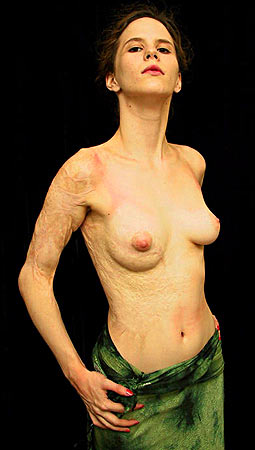

Ella the model.
ELLA:I’ve done mostly artistic nude stuff, some fetish modelling, and a tiny bit of fashion work. Pictures of me have been shown in a few galleries, mostly in Montreal, a couple of small magazines, and of course on the Kink III TV series. There’s also a picture of me that will appear in Hans Neleman’s Body Transform book that he is producing in collaboration with Lukas Zpira. Oh, and on the internet. There are lots and lots and lots of pictures of me on the internet. BME:What kind of cabaret shows have you been in? What made you decide to do that? ELLA:I really, really enjoy performing, and cabaret is something I can do pretty well. I’ve done fetish shows, traditional burlesque shows, and lots of stuff in between. BME:Were you nervous for your first show? What was the audience like?ELLA:Oh, I was shitting myself. I’d done shows before, but this was the first time I’d ever produced something and performed it completely by myself. The audience was much bigger than I was expecting, which didn’t help matters! The response was pretty lukewarm, but it got the ball rolling.BME:What kinds of an act do you have? How long is it?ELLA:My show generally lasts between three and five minutes, depending on the music I use. I try and change it up every once in a while. I generally dance and do fireplay and fire retention using rubbing alcohol and special effects fire to make it look like I’m ‘setting myself on fire’. I once did a show where I sang, which was very scary. It went fairly well, though I was a bit off key! BME:What is Kink III, and how were you involved in it?ELLA:Kink III is a Canadian documentary television series, which was made for the cable channel Showcase. I was one of several subjects that was filmed in Montreal a couple of summers ago. Their researcher saw my website and approached me to be on the show.BME:What kinds of things were shown about you?ELLA:Whatever I could think up that they had permission to film. They showed me doing my laundry, doing a photo shoot, having a barbecue with my friends, going to a vernissage where pictures of me were exhibited, going to a tattoo convention, and doing a show. There were probably other things but I can’t think of them off hand.BME:Do you have any funny or amusing stories from your involvement?ELLA:They filmed me at the Montreal pride parade, and they did a little interview after the parade. This woman was sitting watching us, and after they had stopped the tape she lit into me, telling me how disgusting I was and how I ‘cut myself because I didn’t like myself’. I just flipped her off and walked away, because I don’t believe in fighting with morons, but the crew stayed behind and vociferously defended my honour, which I thought was very sweet.BME:If you could ask yourself one question, what would it be?ELLA:“What’s the most fucked up thing anyone’s ever said about your scars?”
BME:What is Kink III, and how were you involved in it?ELLA:Kink III is a Canadian documentary television series, which was made for the cable channel Showcase. I was one of several subjects that was filmed in Montreal a couple of summers ago. Their researcher saw my website and approached me to be on the show.BME:What kinds of things were shown about you?ELLA:Whatever I could think up that they had permission to film. They showed me doing my laundry, doing a photo shoot, having a barbecue with my friends, going to a vernissage where pictures of me were exhibited, going to a tattoo convention, and doing a show. There were probably other things but I can’t think of them off hand.BME:Do you have any funny or amusing stories from your involvement?ELLA:They filmed me at the Montreal pride parade, and they did a little interview after the parade. This woman was sitting watching us, and after they had stopped the tape she lit into me, telling me how disgusting I was and how I ‘cut myself because I didn’t like myself’. I just flipped her off and walked away, because I don’t believe in fighting with morons, but the crew stayed behind and vociferously defended my honour, which I thought was very sweet.BME:If you could ask yourself one question, what would it be?ELLA:“What’s the most fucked up thing anyone’s ever said about your scars?”On two separate occasions, evangelical Christians have approached me and tried to tell me that if I had ‘enough faith in Jesus’ that my scars would miraculously disappear. Hilariously enough, the second time this happened the bloke was on crutches.
BME:Have you had any feedback from people telling them that you changed their point of view on their own scars?ELLA:Yes, I’ve had a couple of people tell me stuff like that. It’s very flattering, and definitely makes it all worthwhile.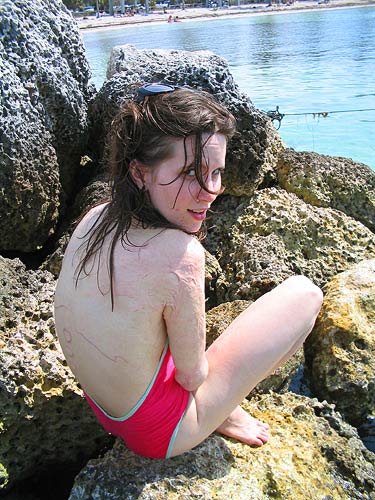
Ella today.
Kudos to Ella. Not only has she accepted what has happened to her, she’s dealing with it in the most positive light. It’s admirable to see someone whose strong body matches a strong mind. She’s a role model for other people who have gone through similar traumatic experiences, she shows people that there’s nothing to be ashamed of, regardless of the level of scarring or deformation that someone has. There’s a strong difference between simply accepting what your body looks like and actually falling in love with its changes. Intentional modifications or not, Ella’s body is beautiful.
Visit Ella at cicatrix.net or on BME’s community site as IAM:ella.

– Gillian Hyde
Gillian Hyde (iam:typealice) is a vagabond, though her roots run deep into Nova Scotian soil. She’s lived and worked on three continents since 2001, and has never lived anywhere for longer than eight months since the age of 16. She loves fonts, puns, being barefoot, and office supplies. “Calm” to her is the roar of the ocean. Online presentation copyright © 2005 BMEzine.com LLC. Picture of Ella by Warren Baird. Front page picture of Amina taken by Steve Prue. Requests to republish must be confirmed in writing. For bibliographical purposes this article was first published online March 25th, 2005 by BMEzine.com LLC from La Paz, Mexico. 
-
BME Newsfeed for Mar 1, 2005
Written by
- 2005-03-01: Australia: JOURNAL ABSTRACT: Amputees By Choice: Body Integrity Identity Disorder and the Ethics of Amputation [by rebekah]
- 2005-03-01: TX: JOURNAL: Tattoo pigment in sentinel lymph nodes: A mimicker of metastatic malignant melanoma [by rebekah]
Please note that links may expire. IAM members, please help out by submitting stories!
-
Waivers and Releases for Tattoo and Piercing Studios [Legal Link]
Written by
Above are sample release forms for tattoo and piercing studios. If you use them, get them reviewed by local counsel first. You may want to edit them to include more (or less — but CYA) risks and medical conditions, or make other changes to suit your studio’s needs.Waivers can protect studios from suit for all different kinds of potential harm, such as infections, scarring and keloiding, allergic reactions to ink or green soap, a kanji placed upside down and, my favorite, misspelled tattoos The simple fact of having signed a waiver and release can discourage many clients from seeking to sue you in the event of a problem. Similarly, a client who goes as far as to talk to a lawyer will find that most lawyers will turn them down as a client if there exists a well-written waiver and release — unless the circumstances are particularly nasty, the lawyer won’t view the case as worth their time and effort. And in the event you do end up in court (or even small claims court), the client’s executed waiver and release will be a strong defense.
GOOD PRACTICE TIP: In the case of spelling a tattoo, it is always a good idea to have the client print out themselves the names or words to be spelled — a good location for this is the back of the waiver or release and have the client initial the spelling.
For clients of piercing and tattoo shops, this means you must be well educated in the risks of the trade and accept those risks before signing your rights away. You always have the option of going to another studio with no waiver to sign or to one that is less restrictive on limiting liability. Or simply don’t get the mod.
KNOW YOUR LOCAL LAW
Laws differ from state to state, city to
city, county to county. Thus, writing any kind of overview of US law is like
hitting that fifth hour of a non-stop tattooing session — it’s outright painful.
(I speak from experience on both counts.) But unlike getting a backpiece, where
the only thing to do is just deal with the pain, here I can lessen the legal
load by providing my own CYA clause:
Get a local lawyer to draft or at least review the free sample waivers provided in this article (Perhaps get other shops nearby to share this cost with you). Do not rely solely on this article as legal advice. A waiver and release that does not take into account the specific laws applicable to where your shop is located may not be any protection for you at all. Instead, feel free to think of this as just learning something new to sound smarter at dinner parties.
With that off my shoulders, let’s
get under the skin of tattoo waivers and releases.Most US states will enforce a waiver or release, although some hold them to a more rigorous standard than others. And at least three states — Louisiana, Montana, and Virginia — have deemed waivers against public policy unenforceable, according to “Liability Waivers” an article on waivers for the health and fitness industry by Dr. Doyice Cotten, co-author of Waivers & Releases for the Health & Fitness Club Industry. The eight states that are most lenient in upholding waivers are Idaho, North Dakota, Michigan, Alabama, Georgia, Tennessee, South Carolina, and Maryland. While Cotten based his research on sports-related waiver cases, the findings could be analogized and extended to tattoo and piercing waivers.
Other states have their own peculiarities. In California, for example, an express waiver of the provisions of Section 1542 of the Civil Code may be necessary to obtain a waiver and release that is effective against future claims. It is standard practice in California for a waiver and release to contain a provision such as the following:
(If you are a resident of the State of California) I agree to waive the provisions of Section 1542 of the Civil Code of the State of California, which provides as follows:
A GENERAL RELEASE DOES NOT EXTEND TO CLAIMS WHICH THE CREDITOR DOES NOT KNOW OR SUSPECT TO EXIST IN HIS FAVOR AT THE TIME OF EXECUTING THE RELEASE, WHICH IF KNOWN BY HIM MUST HAVE MATERIALLY AFFECTED HIS SETTLEMENT WITH THE DEBTOR.
I understand that section 1542 gives
me the right not to release existing claims of which I am not now aware,
unless I voluntarily chose to waive this right. Having been so apprised, I
nevertheless hereby voluntarily elect to, and do waive the rights described in
section 1542, and elect to assume all risks for claims that now exist in my
favor, known or unknown, from the subject of this Waiver and Release. I
acknowledge that I have had the opportunity to consult with legal counsel of
my own choosing and to have the terms of this Waiver and Release fully
explained to me; that I am not executing this Waiver and Release in reliance
on any promises, representations or inducements other than those contained
herein; and that I am executing this Waiver and Release voluntarily, free of
any duress or coercion.GOOD PRACTICE TIP: Know the laws that apply to you. Many states, cities, counties and local munincipalities now regulate tattooing and piercing in some way. You should get a copy of these statutes for your reference and keep them in your shop as well as provide them to any artist working in your shop. And don’t rely on these laws as to not change. Tattooing and piercing, as it has become more mainstream, has attracted greater attention-and motivated some people to seek greater regulations and restrictions on it from restricting who, what and where a person may be tattooed to zoning laws on where you shop may be located. It’s your responsibility to stay up on changing laws that may affect you. It’s much easier and effective to counter an attempt at increased regulation of your profession before such laws are enacted [But that’s for another article.]
NO DRUNKS AND MINORS
Whether your state court will enforce the waiver or release is going to depend on who is signing it. “Capacity” of the person getting the tattoo or piercing is key, according to attorney Ronald D. Coleman of the Coleman Law Firm and general counsel of the Media Bloggers Association. He says:
“At least as important as any issue having to do with the text of the release form is that the tattoo shop owner must be confident that the person getting that tattoo is not impaired and is an adult. [This is “capacity.”] It is not enough for the release form merely to recite the fact that the person signing it contends he is not impaired; if the tattoo shop owner’s own non-expert observation suggests an impairment, this term of the contract likely will ‘not be worth the paper it’s printed on.’ As a general rule, the law will uphold substance, not form.”
What this means is, if a person staggers into your shop drunk, reeking of whiskey, and asks for a Britney Spears portrait tattoo on his chest — even if he’s willing to sign away all liability — he just may come back and sue you when he sobers up and possibly win. “Oops, I did it again” is not a valid legal defense.
Less obvious, a client who speaks fractured English may not be bound by a waiver or release that is written in English. So, if you have a clientele that speaks Spanish, for example, it would be a good idea to have on hand a form of release that is written in Spanish.
It also means that an attractive young woman who could easily pass for 18 years of age and wants to pierce her navel must still provide ID showing she’s the age of consent for this type of piercing in your state. The R. Kelly “she looked 18” excuse just wont cut it unless there’s proof or a parent around.
GOOD PRACTICE TIP: Photocopy the ID’s supplied by the client and parent (if applicable) and attach to the copy of the waiver and release you keep on file. Educate yourself to be able to spot a fake ID or driver’s license as well — and if you are in doubt as to its validity, turn the client away!
Which raises the question: Can parents, signing a tattoo or piercing release form on behalf of their child, thereby, sign away their child’s rights to any damages arising from the procedure?
The answer is yes and no. Again, it all depends on the state, city and county in which your shop is located.
Looking at cases where parents have signed releases for horse riding or ski lessons, cheerleading practices, and a variety of sporting and extracurricular activities, the courts are divided across the US on whether to enforce waivers signed on behalf of minors. For example, a Washington court refused to uphold a ski school’s release even after the mother of a child who was injured during ski lessons signed the agreement releasing the school from any liability for negligence. That court held that parents generally do not have the right to waive their child’s own future action for present injuries sustained from a third party’s negligence. Yet, in a similar case in Colorado, that state’s high court upheld a waiver signed by a parent of an child injured while skiing and found for the defense.
This Colorado case and many other cases that have upheld waivers and releases signed by parents for their minor children cite the 2000 Supreme Court decision of Troxel v. Granville for the principle that “the interest of parents in the care, custody, and control of their children is perhaps the oldest of the fundamental liberty interests recognized by [the US Supreme] Court.”
Therefore, having a child’s belly button pierced is a right that many parents have — as noted, for example, in Connecticut, under General Statutes sec. 19a-92g, explicitly permitting a parent to consent to body piercing of an unemancipated minor child. Just keep in mind that not all state legislatures are as evolved as Connecticut’s.
GOOD PRACTICE TIP: As a general rule, it is probably not a good idea to tattoo a minor — even with a parent’s consent, unless you know the parties very, very well. Whereas a piercing is “temporary”, a tattoo is more permanent and difficult to remove if the wearer or parent later regrets the decision. So, why risk it?
GET THE LANGUAGE RIGHT
Even those state courts that uphold releases
are still going to check to see if the waiver or release is properly drafted.
[While I attempted to make the sample agreements as detailed as possible, they
cannot be considered properly drafted until signed off by an attorney
knowledgeable of your local law.]The problem with many releases is that they are overly broad. Tons of Internet sites offer free legal forms, but I have yet to find one that fully covers the specifics of tattoo and piercing studios.
I did find one that made me laugh on Overlawyered.com that was created by tattooist Pat Fish. In Pat’s release, she also includes the line “I am not a lawyer, nor do I work for one.” For those lawyers that want ink from Pat, she makes them circle the provision and next to it write “But I am ashamed.”
Clauses for professional self-loathing aside, waivers should be specific as to what is involved and what can go wrong. If you own a studio that provides both tattoo and piercing services, have a separate release for each, and have each list their specific risks. For example, the samples provided in the article include risks such as scarring and infection. You could modify the samples so as not to scare away your clients, but like I said, it’s all about CYA.
Another CYA clause, is one that requires the client to properly care for the tattoo or piercing while it’s healing. But Robert Coleman points out that this provision is “fairly worthless if [the client] has not been properly instructed in that care.” He adds, “It is a good idea to give the customer written instructions on care and for him to sign a separate receipt proving that he received them.”
GOOD PRACTICE TIP: Aftercare instructions should be clearly posted on the wall in the studio in a visible and conspicuous place. Each client should receive a printed copy of aftercare instructions BEFORE commencing the tattoo. Upon completion of the tattoo or piercing, the artist should review the aftercare instructions with the client and ask if there are any questions. Keep a pile of aftercare instructions available in the studio’s lobby/waiting area for clients to take with them.
Coleman also favors considering an attorneys’ fees provision in waivers, requiring the loser of any litigation to pay the other side’s attorneys’ fees and costs. “This will certainly discourage meritless litigation. On the other hand, the risks here are fairly obvious.”
An artfully drafted release or waiver with a host of specific provisions on tattooing or piercing is a great line of defense against potential law suits, but the courts will also look to make sure that the client actually read the agreement and understood what they were signing. In my sample waivers, there are lines next to each provision for the client to initial. They are also drafted in clear language, and in readable font, so that you don’t need a law degree or a magnifying glass to read them.
GOOD PRACTICE TIP: Reproduce your waiver and consent form in easily readable type and preferably on a single sheet of paper (printing it on the front and back if necessary) so that the signature is never separated from the waiver itself.
NEGLIGENCE OR GROSS NEGLIGENCE
You’ll also find a provision in my sample
specifically releasing the studio from liability for their own negligence. Some
states, including New York and Delaware, among others, require such language
waiving claims arising from “fault” or “neglect.” Other states don’t require it,
but it may not hurt to have it.Negligence is failure to exercise due care — care that a reasonable, prudent person would exercise under the same circumstances. On the other hand, gross negligence is the failure to use even the slightest amount of care in a way that shows recklessness or willful disregard for the safety of others. While in some cases ordinary negligence can be waived, gross negligence or intentional misconduct cannot. So what does that mean for tattoo and piercing shops? Where is the line drawn between negligence and gross negligence? No US cases were found where the courts look at this line in the context of tattoo and piercing shops, but we can make a guess for the following scenarios:
- Answering the phone and not changing your gloves before touching the client again?
Could be ordinary negligence - Dropping your needles on a dirty floor and then using them on a client?
Sounds like gross negligence. - Tattooing or piercing too deep so as to cause scarring?
Maybe ordinary negligence.
- Tattooing or piercing while drunk or high no matter the outcome?
Probably gross negligence.
Whether a court agrees with these guesses is the real issue — it depends upon an examination of the facts in each circumstance, and a court’s ruling may vary from state to state, county to county. The important point to keep in mind, however, is that no waiver or release can protect you from claims of gross negligence.
GOOD PRACTICE TIP: Do not assume use of a form of waiver or release to absolutely protect you from any claims. It is your responsibility in your shop to institute procedures for all artists and employees to follow to assure that the laws you are subject to are complied with and that procedures to assure the sterility and safety of the application of all tattoos and to prevent the cross-contamination of instruments, surfaces and materials (pigments) is scrupulously followed.
WAIVERS DO NOT COVER ILLEGAL ACTIVITY
According to the basic principles of contract
law, you cannot enforce a contract for illegal activity. Then again, the client
who also engages in the illegality may have little right to sue as well.With the exception of Oklahoma (which is currently reconsidering its state-wide tattoo ban), tattooing and piercings are legal in the US. However, waivers for heavier modifications, such as tongue-splitting, explicitly outlawed in some states, and other mods that fall under laws prohibiting their practice, including practicing medicine without a license, cannot be protected. Performing these modifications may open you up to criminal charges of assault and battery or worse. Some lawyers may also tell you to ask yourself whether you want to have a document attesting to a potentially illegal activity anyway. But you didn’t hear that from me.
For legal waivers, however, hold on to those documents. The safest bet is to keep them filed away until the statute of limitations for any potential law suit has expired in your state. A statute of limitations is a law that prevents a person from bringing a claim after a fixed period of time has passed — irrespective of the validity or worthiness of the claim. With respect to personal injury, most states require a claim be brought within two years — but that time period may not start to run until the person is aware of the injury giving rise to the claim.
GOOD PRACTICE TIP: Retain copies of releases in a safe place for a minimum of three years, and if practicable, even longer. While statutes of limitations may be only two or three years for most claims likely to be brought, in some instances, the statute preventing a claim may not even begin to run until the person knows that they have a claim against you. For example, if the claim results from your publication of a client’s photo without consent, the statute will run only from the date of publication — which could occur years after the initial tattoo was completed.
Finally, the best advice on waivers or releases: don’t rely on them alone to protect you. As Coleman emphasizes, “Insurance, insurance, insurance!”
GOOD PRACTICE TIP: Understand insurance! If the shop you work at has insurance it may cover the shop-but not you individually as an artist!
And with that comes some sound CYA advice.
Marisa Kakoulas
This article was not intended as legal advice. It is intended for only general information purposes. This article does not create any attorney-client relationship.
Special thanks to Rebekah Harris for her invaluable help in legal research and editing.

Marisa Kakoulas is a New York lawyer, writer, and muse of Daniel DiMattia of Calypso Tattoo, living in Liege, Belgium. She works undercover — or just covered up — as a corporate consultant: proof that tattoos and suits are not mutually exclusive. Her book “Tattoo Law”, an overview of US laws affecting the body modification community, is under way. IAM members can visit Marisa at iam:FREE.Copyright © 2005 Marisa Kakoulas. Online presentation copyright © 2005 BMEzine.com LLC. Requests to republish must be confirmed in writing. For bibliographical purposes this article was first published online February 27th, 2005 by BMEzine.com LLC in Johannesburg, South Africa.
- Answering the phone and not changing your gloves before touching the client again?
-
SPIRIT+FLESH: THE ENERGY PULL (PART 1) – Fakir Rants & Raves
Written by


Spirit+Flesh: The Energy Pull:
Part ISpecial Announcements NEW WEB SITE AT FAKIR.ORG
Now up after several years of construction, Fakir is very proud of his brand new web site with lots more information and many color pictures of Fakir schools and Spirit+Flesh workshops. For Body Piercing, Branding and Rituals CLICK HERE.DANCES DVD AVAILABLE AFTER 20 YEARS IN THE DARK
For many years bodymod and piercing fans have asked for copies of this classic film first released in 1986. Now Dances Sacred & Profane is back in circulation as a fantastic DVD REDUX with bonus material. See Fakir and Jim Ward doing the Sun Dance and O-Kee-Pa suspension ritual in Wyoming. For more information, video clips and orders CLICK HERE.MODIFY: A NEW MOVIE WITH FAKIR & LOTS OF BME FAVORITES
Just off the editing machine, an official selection for screening at the TRIBECA Film Festival in NYC in April 2005, this new full length documentary walks a twisted path. Produced over the last two years by Committed Films LLC, this movie is destined for the mainstream. It’s a “must see” for BME fans. For more information, video clips and national showings CLICK HERE.
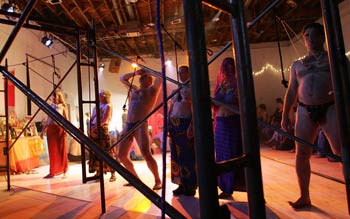
Fakir’s Spirit+Flesh group energy pull and ritual
in Minneapolis, June 2004.
So What’s an Energy Pull?
I first experienced the “energy pull” when I was only about twelve years old (way back in 1942). Being the weird kid that I was, I had already discovered I could pierce needles and pins through my body with impunity — that I could get into a head space where I was a mere witness to cold steel passing through my flesh. In this state of mind I was removed from physical sensation, what the rest of the world called “pain”. But after I had pierced myself, there was no further sensation. Only a static needle stuck through me. It did not hurt. I couldn’t feel it. It was just there.
So wanting to expand my emotional experience, I soon learned to tie a small string around the needle and pull on it. I could pull gently and gradually increase the tension. I was in control of how fast and how much sensation I was receiving. Soon I learned to tie the string to a hook in the wall and pull back against it. I loved doing this and it became a regular practice for me. Every time I did this, I experienced a sweet rush of energy. At this time in my early life, I didn’t analyze what I was doing or try to rationalize it. I just enjoyed it.
In my teens, I lived in libraries (there was no internet for another forty years) and I devoured books. I was very curious to know more about the practice of piercing and pulling. I didn’t take long before I found out that what I was experiencing in my secret basement hideaway was not unique. Piercing and pulling was, in fact, a very ancient and honored practice in several cultures. I learned that in Savite Hindu Culture, they had been doing this kind of body ritual for at least 3,000 years. For them it was a technique for trancing, going beyond the body, leaving the body and allowing the body to be temporarily possessed by higher spirits and archetypes (like Murugan, Lord of Piercing). It was not a display of strength or macho or stoicism or an entertainment. It was the seeking of “a state of grace”.
Even closer to home for me (because I grew up on Indian lands in South Dakota only a few miles from Indian ritual grounds) was the Native American pierce-and-pull ritual called the “Sun Dance”. I didn’t need to study books to learn more about that practice! I had some first hand access to the stories and tales of Native American elders in my own community. I listened to them in the flicker of kerosene lamps as they talked in hushed tones about the glories of the “old days” when Sun Dance was the way to the Great White Spirit. Of course when I was a boy, the ritual had long been made illegal for Native Americans and they could be put in prison if caught secretly doing a Sun Dance. My heart ached for them to be denied the practice of one of their most sacred rites! I guess so far we Modern Primitives are very lucky that what we do has not been made, in most cases, a prisionable offense!
“It’s not how hard you pull, but how long…”
That phrase was a mantra used by Ogallala Sioux medicine men when they were instructing young men before doing a Sun Dance. What most contemporary hook pullers do not seem to understand about this practice is the complex interaction between body and spirit. When one does an “energy pull”, one is manipulating and rearranging the connections between body and spirit. Sure there are physical and chemical changes like the release of the body’s natural opiates, the endorphins. But there is more to it than that. At first there is the sweet rush, euphoria. Some of you know how that feels. But if the pull is prolonged, in concert with strong shamanic intent, there can also be intense visions, healing, travels to unseen worlds, going to core and touching the void. A few of you may have even gotten there. It is not about “trucking” or “tugs of war”.
Since the revival of the Sun Dance in modern times (starting in the 1970s), many of the Native American elders who direct the energy pull called the Sun Dance have noticed and bitterly commented on the conflict they see in some young dancers between traditional Native and Western European values. Western culture, with its focus on competition and individuality, clashes with traditional values of surrender, patience, group energy and letting go of ego. In some recent Sun Dances, young dancers were seen to compete with each other about how hard they could pull, how fast they could break free, how quickly they could be done with the dance. In the old days, a Sun Dance was frequently arranged so whatever the dancer was tethered to could only bend and resist the pulling. Breaking free of the piercing(s) was made impossible. The length of time one could pull against piercings was the truest measure of worth and devotion — and a great way to reach unseen worlds.
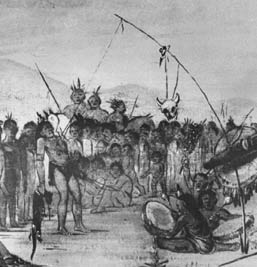
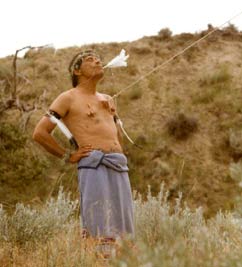
Left: 1830’s George Catlin drawing: prolonged energy pull by Ogalala Sioux against a springy sapling. Right: Fakir does three-hour energy pull during 1982 Wyoming Sun Dance and O-Kee-Pa ceremonies seen in the Dances DVD.
Any meaningful energy pull is not about pain, macho, testosterone or stoicism. It is rather a way of slowly increasing and prolonging the tension until one enters an altered state. In traditional Native American Sun Dances, pulling on piercings was not minutes or even hours, but often days. I personally know several recent Sun Dance pledgers who were pierced and pulled for four days! In Penang Malaysia I saw devotees who pulled on their multiple back hooks from five in the morning till eight at night — 15 hours! In my own experience (see the Dances Sacred & Profane DVD) Jim Ward and I pulled for some three hours before opting to break free. As the Ogalala medicine man said, “It’s not how hard you pull, but how long”. That is what makes the difference between a momentary thrill and a truly memorable and life transforming experience.


Tamil Hindus do day-long energy pulls from multiple hooks. Photos taken by Fakir during the 1995 Thaipusam Festival in Penang, Malaysia.
Opening Fourth Chakras
This brings me to the chapter in my life that began about 1987. Until that time, it was inconceivable to me that anyone else, except Jim Ward, might want to try what I was doing. My first volunteer was my life partner, Cleo. She had lost many friends and lovers in the AIDS epidemic that had begun in the early 1980s. She was filled with grief and heart-centered pain. So at her request, I made a ritual out of piercing her upper chest and back — then attaching balls to tug and pull with every movement. She danced for hours up and down a dusty path on a hillside in Northern California. On each side of the path we had placed stakes with photos of sick fiends, dying friends and those who had passed beyond the veil. She cried. I cried. And we both felt a release of heart-centered pain and grief at the end of the afternoon. I called that ritual a “Ball Dance”. It was then I began to realize the therapeutic effect of tugging and pulling on piercings, especially in the fourth (heart) chakra.
Over the following years, we repeated our piercing rituals and introduced them to many others in the subculture. In 1990, a group of us “ball dancers” got ridiculed and laughed at during the first gathering of Black Leather Wings. Some of the Leather Daddies present dismissed our ritual as a silly and trivial event. A few years later, we met with greater acceptance in Dallas, Texas where Allen Falkner hosted a large “Ball Dance” event that even got mentioned in the newspapers.
During the 1990s, I started experimenting with hooks in the chest (fourth chakra) instead of lighter piercings with attached balls or limes. I found them far more effective in opening the fourth chakra and releasing “stuck” energy. So beginning in 1996, I introduced the “hook pull” to various groups of seekers in the subculture.
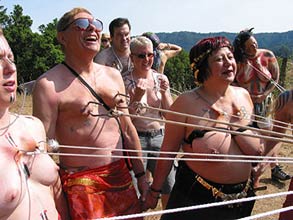

Group energy pulls during day-long BLW rituals in Northern California, 2003/2004
Over the next nine years, the practice of pulling on flesh hooks spread from my first groups of only five or six people to the large number of hook pullers you can now see in the photos posted on BME. However, there is a difference between the hook pullers you see in photos on my Spirit + Flesh web site, and I suspect, most of those in the BME photos. In our shamanically-directed hook pulls we are very conscious of chakras — those important energy centers related to the body that open, close, and change energy flow in both our psychic and physical world. Of all the chakras, the fourth one, the heart chakra, is the most screwed up in our culture. It is the gateway from lower consciousness (survival, self, base emotions) to higher consciousness (love, clear mental activity, inclusiveness, selflessness). If it is blocked and full of crap, we live in world of confusion and misery. We live primarily as victims and make bad decisions. Read some writings of Caroline Myss for more on this. Actually, I wish we could compel our U.S. politicians (especially you-know-who) to participate in a shamanic hook pull and then send them to Caroline Myss.
With this insight, and what I feel was a strong nudge from my Patron Saint Lord Murugan (Hindu Lord of piercing and opening up), we have been doing public Sprit + Flesh Workshops & Rituals for about five years now — with repeat rituals in San Francisco, Los Angeles, Washington D.C., Phoenix and Minneapolis. My partner and I consider these workshops and rituals a humane and needed service more than a vocation. Obviously, we still focus on opening the fourth chakra, and sometimes chakras above number four. But I don’t see much point in doing knee or elbow pulls because there are no chakras there to open, close or manipulate.
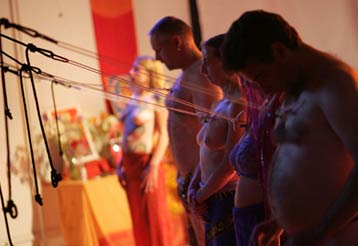
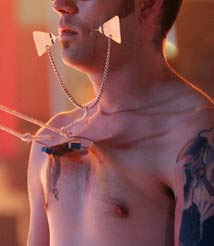
Trance states and the opening of heart chakras was the intent and purpose of group energy pulls in this 2004 Minneapolis Spirit+Flesh ritual. See my web site at fakir.org for participant feedback.
Cleo, My Partner in Spirit + Flesh Rituals Says:
“I have been doing this ritual many times now. Every time it has been a different journey. The whole exploration for me is about altered states, a heightened state, energy, fire (yes it can be really hot), and visions. Most especially if I am pulling alone against a stationary object with my eyes closed. Any awareness of others or spectators quickly disappears. It is a personal dance of ecstatic fire, bright or soft. I went several times to a place that is not a place. Beautiful!”
“My last hook pull ritual was like wringing my heart from its grief. During the second stage it was a very sexy, a big energy exchange with my puller/lover. The third phase was fun and releasing as I pulled in a big circle with other dancers. You connect intimately with friends, lovers and even strangers pulling on your cords, tuning in to each other, experiencing group energy in a ceremonial tribal ring. At the end I was laughing and very high in this pool of energy and fantastic live drumming.
”
In the second part of SPIRIT+FLESH: THE ENERGY PULL, I would like to take you on a guided tour of some of the more memorable experiences we’ve have had, even in our next ritual which is only one week away in San Francisco. I’ll include some more photos and also feedback comments from energy pull participants. And if hook pulls must be entertainment, at least they can be “art” as my friends Vaughn and Joey Wyman of Body Manipulations did a few years ago. We’ll get into that and more in my next column.
Yours for safe and enlightened journeys,

Fakir Musafar
fakir at bodyplay dot com
Fakir Musafar is the undisputed father of the Modern Primitives movement and through his work over the past 50 years with PFIQ, Gauntlet, Body Play, and more, he has been one of the key figures in bringing body modification out of the closet in an enlightened and aware fashion.For much more information on Fakir and the subjects discussed in this column, be sure to check out his website at www.bodyplay.com. While you’re there you should consider whipping out your PayPal account and getting yourself a signed copy of his amazing book, SPIRIT AND FLESH (now).
Copyright © 2005 BMEzine.com LLC Requests to republish must be confirmed in writing. For bibliographical purposes this article was first published February 25th, 2005 by BMEzine.com LLC from Los Angeles, CA, USA.
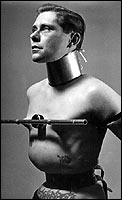
-
BME Newsfeed for Feb 25, 2005
Written by
- 2005-02-25: United Kingdom: Face piercing rule angers father [by LostVoodoo]
- 2005-02-25: United Kingdom: Body piercers ‘suffer in silence’ [by LostVoodoo]
Please note that links may expire. IAM members, please help out by submitting stories!
-
NASTY, NASTY CLIENTS [The Publisher’s Ring]
Written by

Nasty, Nasty Clients!
“Your most unhappy customers are your greatest source of learning.”
– Bill GatesI recently interviewed a couple hundred piercers about the low points of their career. You know how they say “the customer is always right”? Well, these piercers might not agree with that claim. Their stories break down into the four sections of this article:
- The customer is always
rightstinky
Stories about piercing clients with serious lapses in personal hygiene.
While I think most piercers have ran across the occasional hedge that needs to be trimmed, or butt-crack that needs a good washing, the worst hygiene problem I’ve encountered was a session during a hood piercing. Once she was on the table and went to go spread her legs, I got a blast of a smell that nearly floored me, but the visual was the worst part. This stringy white and yellow shit was all over her cooter, and as she spread her legs, it stretched like a spider web. It was nasty. Stinky crotch goo.
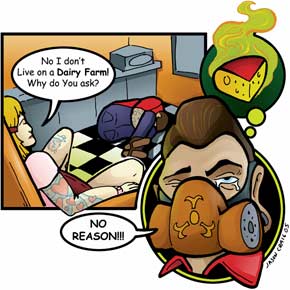
- The customer is always
rightperverted
If you get aroused by this section, stick to self piercing.
I had a guy once while getting his frenum pierced start sticking his finger in his own anus and sort of masturbating it, just moving it in and out of his anus. I asked “Um… what are you doing?” And he replied, as if nothing was wrong, “oh when I feel pain this makes it better.” I told him he couldn’t do that in here and he agreed but continued to do it. I just very quickly finished with the piercing and told him not to touch anything on his way out.
- The customer is always
rightsuicidal
A compendium of some of the insane things people do to themselves when the piercer isn’t there to help.
I saw a kid that tried to stretch his own tongue with the latch from an outdoor gate (the hook in eye-bolt kind). He came in because once he got the hook through the hole he couldn’t get it to move. So for a day he was walking around with a patio latch hanging out of his mouth. That procedure required cutting the material out of the tongue.
- The customer is always
rightangry
Encounters with violent and deranged clients are far too common.
A guy came in ready to kill us for piercing his underage daughter. We tried to find out who it was — he even said she would have used a fake ID, but we didn’t even the name of the fake ID on record so we told him we didn’t do it. This just made him even more upset. He was like well she told me she got it at blah blah blah shop, and we where like “uhh… sir, this isn’t even that shop!” He looked at us all dumbfounded and turned and walked away… he later came back to get a tattoo.
Reconsidering taking on a glamorous life as a piercer? As one of the piercers I talked to put it, “and people seem to think I have a fucking dream job.”
Next time you go and get a piercing, please, at least have a shower first.

Shannon Larratt
BME.comIllustrations by Jason Craig (iam:jasonthe29th).
- The customer is always

